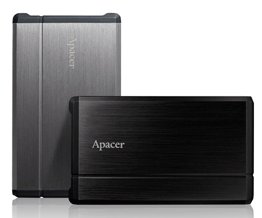
Posted on Wednesday, November 10 2010 @ 16:59 CET by Thomas De Maesschalck
Apacer announced the AC430, a new USB 3.0 HDD that's available in 500GB and 640GB capacities. The disks promise read speeds of up to 92MB/s and write speeds of up to 85MB/s.
USB 3.0 is without a doubt the most talked about new technology, with USB 3.0 desktops and notebooks already setting the tone in this rapidly changing market. Apacer Technology Inc., a global leader in memory storage, is proud to announce its first high-speed USB 3.0 external HDD: the Apacer AC430.
This latest HDD model has a read and write speed up to 92MB and 85MB per second, which is three times faster than USB2.0 equivalent models. Available in 500GB and 640GB capacities, the Apacer AC430 USB 3.0 External HDD is your first step into the next generation of USB.
Super speed 2.5 inch USB3.0 SATA Hard Drive
The Apacer AC430 features a SATA Hard Drive with USB 3.0 interface; the actual read and write speed reaches up to 92MB and 85MB/s. This means it takes only 7.5 minutes for the AC430 Hard Drive to transfer a 38GB blue-ray movie, as compared to 20 to 30 minutes for a USB 2.0 connection! It can save up to 75% of your time to transfer the multimedia files of considerable size.
Elegant aluminium enclosure with a built-in anti-shock design
Apacer AC430 not only looks sleek with its aluminium enclosure, but also stylish because of its flawless metallic hairline finish. Among the advantage is the superior heat emission capacity to assure a stable performance during extended use. In addition, the built-in anti-shock design helps to protect your hard drive and secure precious data.
Built-in power management
The Apacer AC430 features plug and play functionality and backward compatibility with USB 2.0 specifications. The AC430 offers the fastest transmitting speed while ensuring data integrity. With the configuration of the operation system, the built-in smart power management can automatically enter sleep mode after 10 minutes and effectively slashes power consumption, which can extend the product life.
